Large Trucks (Big Rigs) and Recreational Vehicles (RVs)
To reduce the chance of having a collision with a large truck or RV, you must be familiar with a big rig’s physical capabilities and how it maneuvers.
Braking
Large trucks take longer to stop than passenger vehicles traveling at the same speed. The average passenger vehicle traveling at 55 mph can stop within 400 feet. However, a large truck traveling at the same speed can take almost 800 feet to stop. Do not move in front of a large truck and suddenly slow down or stop. The truck driver will not be able to stop quickly enough to avoid crashing into you.
Trucker’s Blind Spots – The “No Zone”
Shaded areas are the driver’s blind spots.
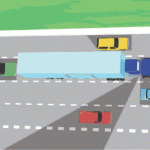
Passenger vehicle drivers incorrectly assume that a trucker can see the road better because they are higher off the road. While truckers do have a better forward view and bigger mirrors, they still have large blind spots or “NO ZONES” where your vehicle can disappear from a truck driver’s view.
If you stay in those blind spots, you block the trucker’s ability to take evasive action to avoid a dangerous situation. Generally speaking, if you cannot see the truck driver in their side mirror, they cannot see you.
Turning
When a vehicle makes a turn, the rear wheels follow a shorter path than the front wheels. The longer the vehicle, the greater the difference in the turning path. This is why big rig drivers must often swing wide to complete a right turn. When you follow a big rig, look at its turn signals before you start to pass. If the truck appears to be turning left, check the turn signals again; the driver may actually be turning right but first swinging wide.
Maneuverability
Trucks are not as maneuverable as passenger vehicles. Large trucks have longer stopping and starting distances. They take more space for turns and weigh more. When no signs are posted, these vehicles must be driven in the right traffic lane or as close as possible to the right edge of the roadway.
On a divided highway with 4 or more traffic lanes in one direction, these vehicles may also be driven in the lane just to the left of the right lane.
Avoid these mistakes when driving around large trucks:
- Cutting off a truck in traffic or on the highway to reach an exit or turn. Cutting into the open space in front of a truck is dangerous. Slow down and take your turn entering the construction zone. Do not speed up to pass a truck, so you can exit the roadway. Take a moment to slow down and exit behind a truck.
- Lingering alongside a truck when passing. Always pass a large truck on the left side, and after you pass the truck, move ahead of it. Do not linger. Otherwise, you make it very difficult, if not impossible, for the trucker to take evasive action if an obstacle appears in the road ahead.
- Following too closely or tailgating. When you follow so closely behind a truck that you cannot see the truck driver’s side view mirrors, the trucker cannot see you and has no way of knowing you are there. Tailgating a truck, or any vehicle, is dangerous because you decrease your own safety distance if the vehicle in front of you stops quickly.
- Underestimating the size and speed of an approaching tractor-trailer. A large tractor-trailer often appears to be traveling at a slower speed because of its large size. Many collisions involving a passenger vehicle and large truck occur at intersections, when the passenger vehicle’s driver did not realize how close the truck was or how fast it was traveling.
Buses, Streetcars, and Trolleys
Do not drive through a safety zone, which is a space set aside for pedestrians, marked by raised buttons or markers on a roadway. When people are boarding or leaving a streetcar or trolley where there is no safety zone, stop behind the vehicle’s nearest door or vehicle platform and wait until the people have reached a safe place. When a bus, streetcar, or trolley is stopped at a safety zone or at an intersection where traffic is controlled by a peace officer or traffic signal light, you may pass at no more than 10 mph.
Do not overtake and pass any light-rail vehicle or streetcar on the left side, whether it is moving or standing.
Exceptions:
- When you are on a one-way street.
- When the tracks are so close to the right side that you cannot pass on the right.
- When a traffic officer directs you to pass on the left.
Light Rail Vehicles
Light-rail vehicles have the same rights and responsibilities on public roadways as other vehicles. Although everyone must follow the same traffic laws, light-rail vehicles require exceptional handling ability because of their size.
Safely share the road with light-rail vehicles by:
- Being aware of where light-rail vehicles operate. Buildings, trees, etc., cause blind spots for the trolley operator.
- Never turning in front of an approaching light-rail vehicle.
- Maintaining a safe distance from the light-rail vehicle if it shares a street with vehicular traffic.
- Looking for approaching light-rail vehicles before you turn across the tracks. Complete your turn only if a traffic signal light indicates you may proceed.
Do not turn in front of light rail vehicles
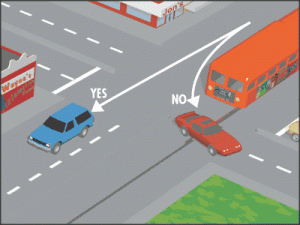
Safety Zones are marked by dotted white lines
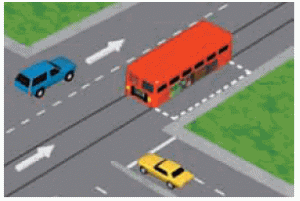
Note: Light-rail vehicles can interrupt traffic signal lights. Do not proceed until the traffic signal light indicates you may proceed.
Emergency Vehicles
You must yield the right-of-way to any police vehicle, fire engine, ambulance, or other emergency vehicle using a siren and red lights. Drive to the right edge of the road and stop until the emergency vehicle(s) have passed. However, never stop in an intersection. If you are in an intersection when you see an emergency vehicle, continue through the intersection and then, drive to the right as soon as it is safe and stop. Emergency vehicles often use the wrong side of the street to continue on their way. They sometimes use a loudspeaker to talk to drivers blocking their path.
Yield to Emergency Vehicles
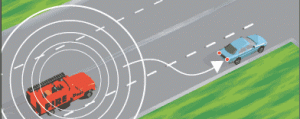
You must obey any traffic direction, order, or signal given by a traffic or peace officer, or a firefighter even if it conflicts with existing signs, signals, or laws.
It is against the law to follow within 300 feet behind any fire engine, police vehicle, ambulance, or other emergency vehicle with a siren or flashing lights (CVC §21706).
If you drive for sight-seeing purposes to the scene of a fire, collision, or other disaster, you may be arrested. Casual observers interfere with the essential services of police, firefighter, ambulance crews, or other rescue or emergency personnel.
Slow Moving Vehicles
Some vehicles are not designed to keep up with the speed of traffic. Farm tractors, animal-drawn carts, and road maintenance vehicles usually travel 25 mph or less. Slow-moving vehicles have an orange/red triangle on the back of the vehicles. It
looks like the sign in the picture to the right. Look for these vehicles and adjust your speed before you reach them.
A Slow Moving Vehicle
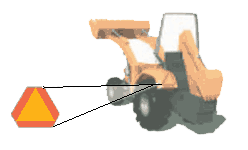
Also, be aware that large trucks, bicyclists, and small-underpowered cars lose speed on long or steep hills and take longer to get up to speed when entering traffic.
Other types of slow-moving motorized vehicles, such as wheelchairs, scooters, neighborhood electric vehicles (NEVs), and golf carts may legally operate on public roads. Adjust your speed accordingly to accommodate them.
Vehicles proceeding at a speed less than the flow of traffic and moving on a two-lane highway where passing is unsafe, must turn off the roadway at the nearest place designated as a turnout or wherever sufficient area for a safe turnout exists, if a line of 5 or more vehicles forms behind them.
Neighborhood Electric Vehicles (NEV) and Low-Speed Vehicles (LSV)
When you see these signs or markings: NEV USE ONLY or NEV ROUTE, watch out for slow-moving vehicles in the roadway. NEVs and LSVs are restricted from roadways where the speed limit is greater than 35 mph (CVC §§385.5 and 21260). NEVs and LSVs reach a maximum speed of 25 mph. Owners of registered NEVs and LSVs must comply with financial responsibility laws and have a valid DL to operate the vehicle.
Animal-Drawn Vehicles
Horse-drawn vehicles and riders of horses or other animals are entitled to share the road with motor vehicles. It is a traffic offense to scare horses or stampede livestock. Slow down or stop, if necessary, or when requested to do so by the riders or herders.
Motorcycles
Motorcyclists have the same rights and responsibilities as automobile drivers. While everyone must follow the same traffic laws, motorcyclists face additional dangers because motorcycles require exceptional handling ability and are harder to see. Therefore, many motorcycles keep their headlight on at all times, even during daylight hours.
Motorcyclists can do many things to increase their chances of being seen by drivers and other road users, including:
- Wearing a bright-colored jacket, vest, and helmet.
- Wearing reflective material on helmets and clothes.
- Using turn signals when planning to change lanes or turn.
- Flashing their brake lights before slowing down to help others notice the motorcycle.
- Avoiding blind spots of other vehicles and not lingering between vehicles when lane splitting.
- Using high beam headlights during daylight hours.
Follow these rules to respect the right-of-way and safely share the road with motorcyclists:
- When you change lanes or enter a major thoroughfare, make a visual check for motorcycles and use your mirrors. Motorcycles are small and can easily disappear into a vehicle’s blind spots.
- Allow a 4 second following distance. You will need this space to avoid hitting the motorcyclist, if they brake suddenly or fall off the motorcycle.
- Whenever possible, allow the motorcycle a full lane width. Although it is not illegal to share lanes with motorcycles, it is unsafe.
- Never try to pass a motorcycle in the same lane you are sharing with the motorcycle.
- Whenever possible, move to one side of your lane to give motorcyclists ample room to pass.
- Look carefully for motorcyclists before opening doors next to moving traffic or before turning right.
- When you make a turn, check for motorcyclists and gauge their speed before turning.
- Look carefully for motorcyclists before opening doors next to moving traffic or before turning right.
- Different road conditions, like potholes, gravel, wet or slippery surfaces, pavement seams, railroad crossings, and grooved pavement, can cause motorcyclists to change speed or direction suddenly. If you are aware of the effect of these conditions and drive with care and attention, you can help reduce motorcyclist injuries and fatalities. For more information regarding motorcycle safety, visit the California Motorcyclist Safety Program at www.chp.ca.gov/programs-services/programs/california- motorcyclist-safety or 1-877-RIDE-411.
Bicycles

Bicyclists have the same rights and responsibilities as vehicle and motorcycle drivers, including:
- Obeying all traffic signs and signal lights.
- Riding in the same direction as traffic.
- Signaling when changing lanes or turning.
- Yielding to pedestrians.
- Wearing a helmet (if under 18 years old).
- Allowing faster traffic to pass when safe.
- Staying visible (e.g., never weave between parked vehicles).
- Riding as near to the right curb or edge of the roadway as practicable.
- Not riding on the sidewalk, unless allowed by the city where you’re riding.
- Making left and right turns in the same way drivers do, using the same turn lanes. If the bicyclist is traveling straight ahead, they should use a through traffic lane rather than ride next to the curb and block traffic making right turns.
Bicyclists shall not operate a bicycle on a roadway unless the bicycle is equipped with a brake which will enable the operator to make a one-wheel skid on dry, level, clean pavement.
Turns for bicyclists
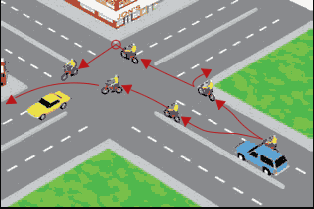
Intersections with special lanes
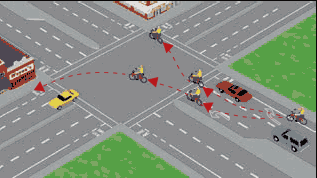
During darkness, bicyclists should avoid wearing dark clothing and must have the following equipment:
- A front lamp emitting a white light visible from a distance of 300 feet.
- A rear red reflector or a solid or flashing red light with a built in reflector that is visible from a distance of 500 feet.
- A white or yellow reflector on each pedal or on the bicyclist’s shoes or ankles visible from a distance of 200 feet.
- A white or yellow reflector on the front wheel, a white or red reflector on the rear wheel, or reflectorized tires.
Bicyclists have the right to operate on the road and may:
- Lawfully be permitted to ride on certain sections of freeways where there is no alternate route and bicycling is not forbidden by a sign.
- Move left to avoid hazards such as parked or moving vehicles, bicycles, animals, or debris.
- Choose to ride near the left curb or edge of a one-way street.
Bicycles In Travel Lanes
Bicyclists traveling slower than the flow of traffic must ride as close as practicable to the right curb or edge of the roadway except in the following situations:
- Passing a vehicle or another bicycle in the same direction.
- Preparing to make a left turn at an intersection, into a private road, or at a driveway.
- When necessary to avoid a hazard or road condition (i.e., pedestrians, animals, surface hazards).
- When a lane is too narrow for a bicycle and a vehicle to travel safely side-by- side within the lane.
- When approaching a right turn.
- If the roadway is a one-way road with two or more lanes. In this case, a bicyclist may ride near the left curb or edge of roadway as practicable. With any slow-moving vehicle or bicycle, drivers should follow at a safe distance and, when it is safe, the bicyclist should move to a position that allows vehicles to pass.
Right Wrong
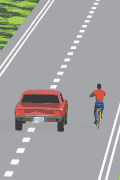
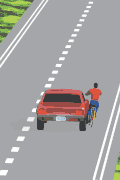
Passing a bicyclist that is in the travel lane at a safe distance may require changing into another lane, passing safely and quickly, and returning to your original lane leaving room between your vehicle and the bicyclist. When you cannot change lanes to pass a bicyclist, allow at least 3 feet between your vehicle and the bicyclist. If you are unable to pass within 3 feet of space, pass at a safe speed to not endanger the bicyclist.
Here are some critical points for drivers and bicyclists to remember. Motor vehicle drivers must:
- Pass bicyclists allowing enough room to avoid forcing them into parked vehicles or doors that are open into traffic.
- Merge toward the curb or into the bike lane only when it is safe.
- Merge safely behind a bicyclist when preparing to make a turn.
- Only enter a bike lane no more than 200 feet before starting a turn.
- Make a visual check for bicyclists when changing lanes or entering traffic. Bicycles are small and may be hidden in a vehicle’s blind spot.
- Be careful when approaching or passing a bicyclist on a two-lane roadway.

Pedestrians Who Are Blind
Pedestrians using guide dogs or white canes with or without a red tip must be given the right-of-way at all times. These pedestrians are partially or totally blind. When these pedestrians are in your vicinity, be especially careful when turning corners or backing up, particularly if you are driving a quiet hybrid vehicle.
Here are some suggestions for helping pedestrians who are blind:
- At a stop light or sign, do not stop your vehicle more than 5 feet from the crosswalk, unless there is an advance stop bar (line). Blind pedestrians rely on the sound of your vehicle to become aware of your vehicle’s presence; so, it is important that you stop your vehicle within 5 feet of the crosswalk. Drivers of hybrid or electric vehicles must remain especially aware that the lack of engine or electric motor noise may cause a blind pedestrian to assume there is not a vehicle nearby. Follow this cue: When a blind person pulls in their cane and steps away from the intersection, this gesture usually means they are not ready to cross the street and for you to go.
- Stop at all crosswalks where pedestrians are waiting. Wait for the pedestrian to cross the street.
- Do not stop in the middle of a crosswalk. This forces the blind pedestrian to go around your vehicle and into traffic outside of the crosswalk.
- Do not give the blind pedestrian verbal directions. A blind pedestrian listens to all traffic sounds before deciding to cross the street.
- Do not turn right without looking first. Look for any pedestrians, especially blind pedestrians or traffic, before starting your turn. Blind pedestrians who have a green light are not expecting a driver to make a right turn in front of them. Turning may result in the blind pedestrian becoming disoriented and vulnerable to being hit by another right turning vehicle when attempting to cross the street.
- Do not honk your horn at a blind person. The blind person has no idea who you are honking at and may be startled by the noise.
- Do not block any sidewalk.
Road Workers and Work Zones (Cone Zones)
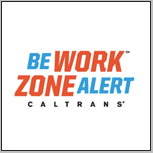 Signs and message boards warn you of workers, slow- moving equipment, and closed lanes ahead. Cones, drums, or other barriers will guide you through the work zone. Reduce your speed and be prepared to slow down or stop for highway equipment. Merge as soon as it is safe to do so and without crossing the cones or drums. In work zones where lanes are narrow or where the shoulder is closed, watch for bicycles and “share the road” when they are present. Watch for work zone speed limit and reduced speed limit warning signs.
Signs and message boards warn you of workers, slow- moving equipment, and closed lanes ahead. Cones, drums, or other barriers will guide you through the work zone. Reduce your speed and be prepared to slow down or stop for highway equipment. Merge as soon as it is safe to do so and without crossing the cones or drums. In work zones where lanes are narrow or where the shoulder is closed, watch for bicycles and “share the road” when they are present. Watch for work zone speed limit and reduced speed limit warning signs.
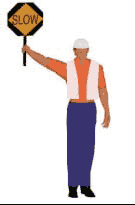
For your own safety and the safety of your passengers remember to pass the work zone carefully, slow down, allow extra following room between vehicles, merge early, expect sudden slowing or stopping, watch for drivers changing lanes at the last minute, and avoid distractions while driving in a work zone. Distractions include using your hands-free cell phone, reading/sending text messages, and/or operating your GPS and entertainment systems. Fines for traffic violations in a work zone can be $1,000 or more. Anyone convicted of assaulting a highway worker faces fines of up to $2,000 and imprisonment for up to 1 year.
Do not stop or slow down to watch the road work. Obey special signs or instructions from workers (flaggers).
Double Fine Zones
Due to increased collision-related injuries and fatalities, certain roads are designated as “Safety Enhanced-Double Fine Zones.” Fines for violations are doubled in these zones and also in highway construction or maintenance zones when workers are present (CVC §42010).
Move Over and Slow Down
Drivers are required to move over a lane, if safe to do so, or slow down when approaching a stationary emergency vehicle or tow truck that is displaying flashing amber warning lights, or a Department of Transportation (Caltrans) vehicle displaying emergency flashing or amber warning lights while stopped on the side of a state highway or freeway. The law is designed to reduce the deaths of peace officers, tow truck drivers, paramedics, Caltrans employees, and other emergency personnel who are aiding stranded or injured motorists or involved in road work.
Vehicles With Hazardous Loads
A diamond-shaped sign on a truck means that the load on the truck is potentially dangerous (gas, explosives, etc.). Vehicles which display these signs are required to stop before crossing railroad tracks.
Hazardous Load Placards

Dealing with Traffic Congestion
Small changes in your driving habits can help relieve chronic traffic congestion.
Avoid the following driving behaviors:
- Tailgating–following too closely.
- Unnecessary lane changes–weaving in and out of freeway lanes.
- Inattention–eating, grooming, talking on a cell phone, text messaging, reading the newspaper, etc.
- Operating a poorly-maintained or malfunctioning vehicle or running out of fuel or battery charge.
Dealing with Aggressive Drivers and Road Rage
Aggressive driving can cause many serious problems on the roadway. All drivers must be aware of both aggressive driving and the behavior known as “road rage,” and what to do when they occur.
There are two important things to be aware of regarding aggressive drivers:
- Recognizing and avoiding the behaviors in yourself.
- Avoiding other drivers engaging in these behaviors.
Ways to avoid becoming an aggressive driver include:
- Allow plenty of time to reach your destination.
- Do not “cut off” other drivers.
- Do not drive slowly in the left (fast) lane.
- Do not tailgate.
- Do not gesture to other drivers.
- Use your horn for emergencies only.
- Let aggressive drivers pass you.
The following are examples of common behaviors that can lead to aggressive driving and how to avoid them:
- Lane Blocking–Don’t block the passing lane. Stay out of the far left lane if other traffic wants to drive faster, and yield to the right for any vehicle that wants to pass.
- Tailgating–Maintain a safe distance from the vehicle in front of you. If you are being tailgated, leave more space between you and the vehicle in front of you.
- Signal Lights–Always use your signals when changing lanes, and avoid changing lanes too close to the other vehicles. After you have changed lanes, turn your signal off.
- Gestures–If you must gesture to another driver, do so in a way that will not be interpreted as hostile or obscene.
- Horn–Avoid using your horn to say “hello” to a pedestrian. The driver in front of you might think you are honking at them.
- Failure to Turn–Unless otherwise posted, right turns are allowed after a complete stop at a red light. Choosing to wait for the green light may frustrate the drivers behind you, but is not illegal.
- Parking–Do not take more than one parking space. Do not park in the disabled parking space if you do not have a disabled parking placard or plates.
- Headlights–If you use your high-beam headlights, dim your lights for oncoming traffic and when approaching a vehicle from behind; do not retaliate to oncoming high beams with your own.
- Merging–When traffic permits, make room to allow vehicles to merge into your lane.